Let’s explore the intriguing world of caterpillars found in the scenic state of Maine. This article will highlight 18 of these interesting caterpillars — some common, some remarkable, and a few that come with a warning tag due to their poisonous nature. Perfect for nature enthusiasts, budding lepidopterists, or anyone who seeks to tread the outdoors with an informed mind, our guide differentiates between the safe-to-handle and the better-to-avoid caterpillars you may come across in Maine. Let’s dive in and get to know these slimy and furry creatures!
1. Bent-Line Dart Caterpillar (Choephora fungorum)
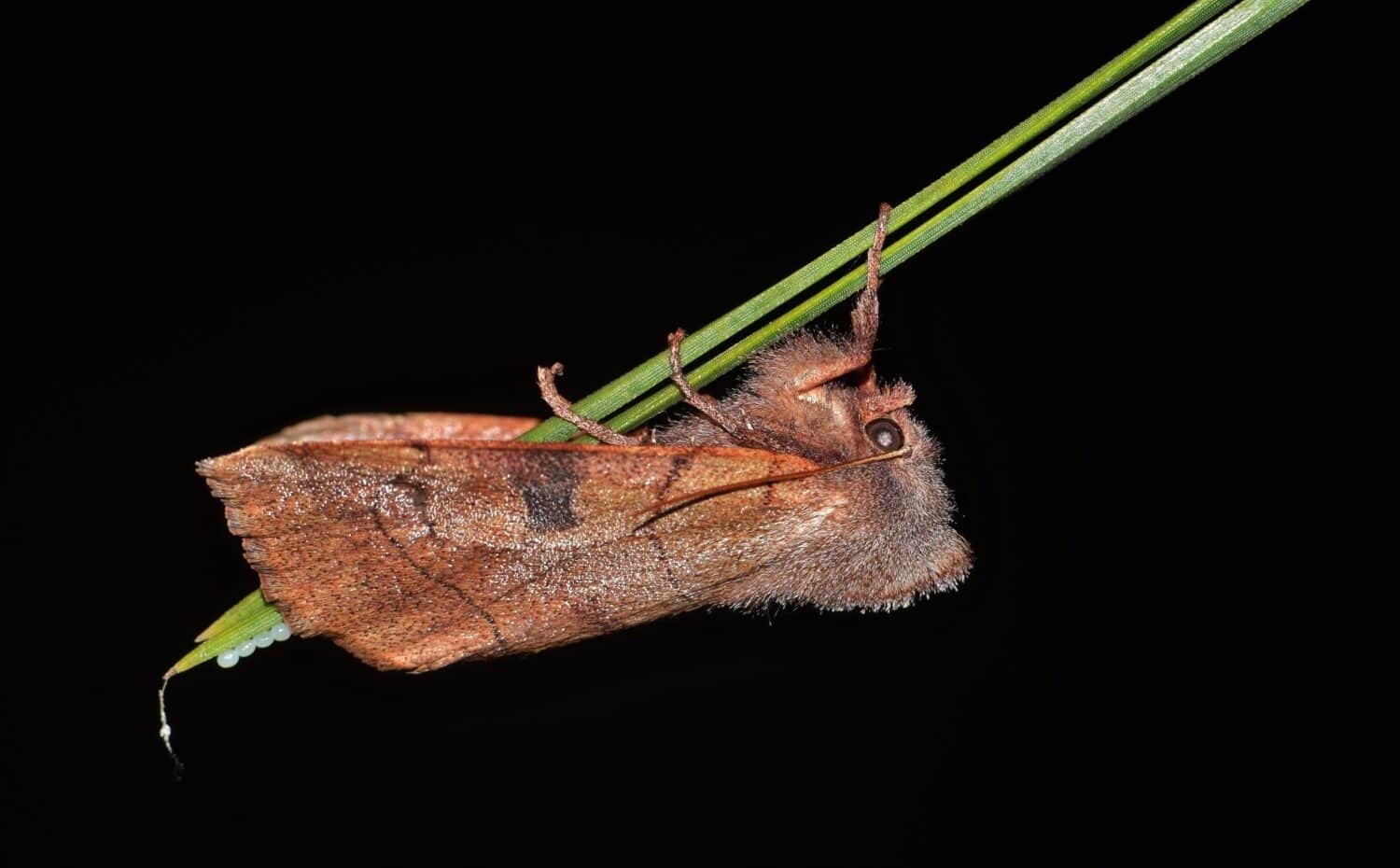
Bent-line dart caterpillars, much like their adult form (pictured above), have earthy brown tones.
©Brett Hondow/Shutterstock.com
In Maine, keep an eye out for these subtly colored caterpillars leisurely crawling through the fallen leaves at the onset of spring.
The sleek caterpillar of the bent-line dart moth predominantly boasts earthy brown tones, perfectly camouflaging it within the leaf litter. The body is marked with dark stripes leading toward its rear end. Its meals typically consist of low-lying vegetation often dismissed as weeds, such as dandelion, clover, and trefoil. Moreover, the caterpillar also favors tobacco plants.
If you come across this caterpillar, don’t worry, as the bent-line dart is not poisonous.
2. Black-Waved Flannel Caterpillar (Megalopyge crispata)
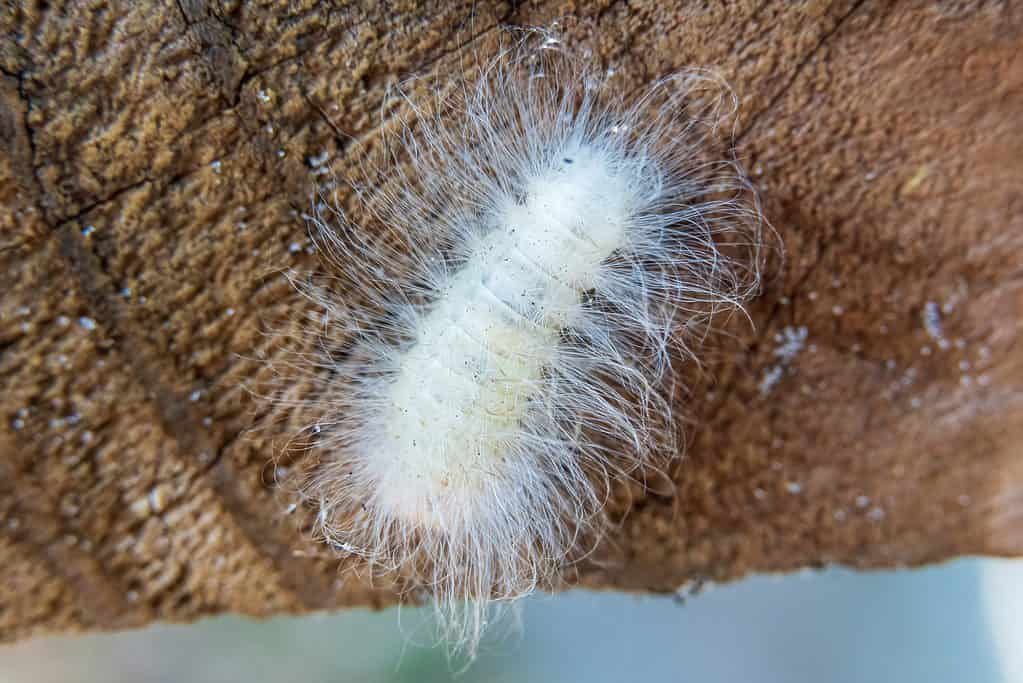
Black-waved flannel moth caterpillars have long, plush-like hairs that help protect them against predators.
©Sunshower Shots/Shutterstock.com
Though the black-waved flannel moth caterpillar may appear delicate and inviting to the touch, it’s surprisingly harmful.
Concealed within the long, wavy, and shorter, plush-like hairs are stinging bristles that act as the caterpillar’s defense mechanism against predators. The color palette of this caterpillar isn’t constant; it varies, ranging from bright white to different shades of brown, orange, and a mix of gray and yellow. Despite their inviting appearance, it’s advisable to refrain from touching them, as they are venomous!
This caterpillar is not picky about its food and enjoys nibbling on leaves from a variety of trees and shrubs. As they aren’t picky, they can be found in various locations, including parks and playgrounds.
3. Buck Moth Caterpillar (Hemileuca maia)

These buck moth caterpillars can be found in Maine all the way south to Florida.
©iStock.com/Oleg Marchak
Buck moth caterpillars are sizeable and dark in color. These caterpillars measure between 2 and 2.4 inches long. They exhibit reddish heads, and their bodies are dotted with tiny round white spots. You can find them scattered from Maine all the way to Florida.
Primarily, buck moth caterpillars are known to feast on a variety of oak trees, including scrub oak and live oak.
Interestingly, this caterpillar is part of a unique group that possesses skin filled with stinging spines connected to venom glands. Upon contact with human skin, these spines can trigger a distressing rash and deliver a stinging sensation that brings immediate pain.
4. Cabbage Looper (Trichoplusia ni)
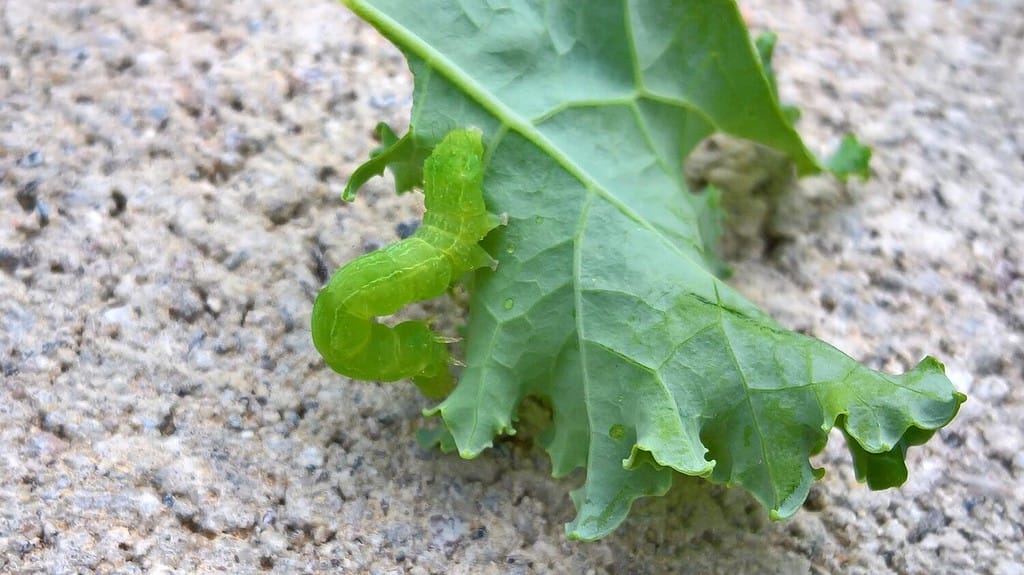
Don’t worry if you accidentally ingest a cabbage looper caterpillar, they are entirely harmless!
©amy71465/Shutterstock.com
Cabbage loopers are green and sport a slender white stripe on either side with multiple thin lines running down their back. They have a distinctive hump on their back as they navigate their way.
These caterpillars are notorious for infesting cole crops like cabbage, collards, broccoli, cauliflower, and turnips. Aside from these, cabbage loopers also nibble on various other vegetables, such as lettuce, celery, beets, and potatoes.
One comforting fact is that these caterpillars are entirely harmless to humans, even if they’re accidentally consumed or touched.
5. Cecropia Moth Caterpillar (Hyalophora cecropia)

Although it may look poisonous, the cecropia moth caterpillar is harmless.
©K Hanley CHDPhoto/Shutterstock.com
The cecropia moth caterpillar boasts an impressively large body, with its final-stage larvae growing up to a length of 4.5 inches. Its vivid or marine green body is marked by notable dorsal bumps, each topped with black spines. While the bumps on its thorax are of an orange to red shade, the abdominal ones are yellow, and those on its sides are a soft blue hue.
This caterpillar has a diverse palate, enjoying the leaves of various shrubs and trees such as birch, ash, box elder, poplar, plum, willow, apple, and elm.
Despite its unusual and intriguing appearance, the cecropia moth caterpillar isn’t poisonous. Its peculiar look, however, serves as an effective deterrent against certain predators.
6. Eastern Black Swallowtail Caterpillar (Papilio polyxenes)

The green and black stripes of the eastern black swallowtail caterpillar make this insect stand out.
©Graphicato/Shutterstock.com
The eastern black swallowtail caterpillar is initially black in color and adorned with a white belt around its middle section. As it matures, the caterpillar adopts green and black stripes punctuated with yellow spots.
Known to feast on a range of herbs and wild plants, the eastern black swallowtail caterpillar feeds on a variety of different plants in the carrot family as well, including carrots, celery, dill, parsnip, and parsley.
Although these caterpillars are not poisonous, eastern black swallowtail caterpillars may have an unpleasant taste to bird predators due to the toxins they ingest from their host plants.
7. Eastern Tiger Swallowtail Caterpillar (Papilio glaucus)
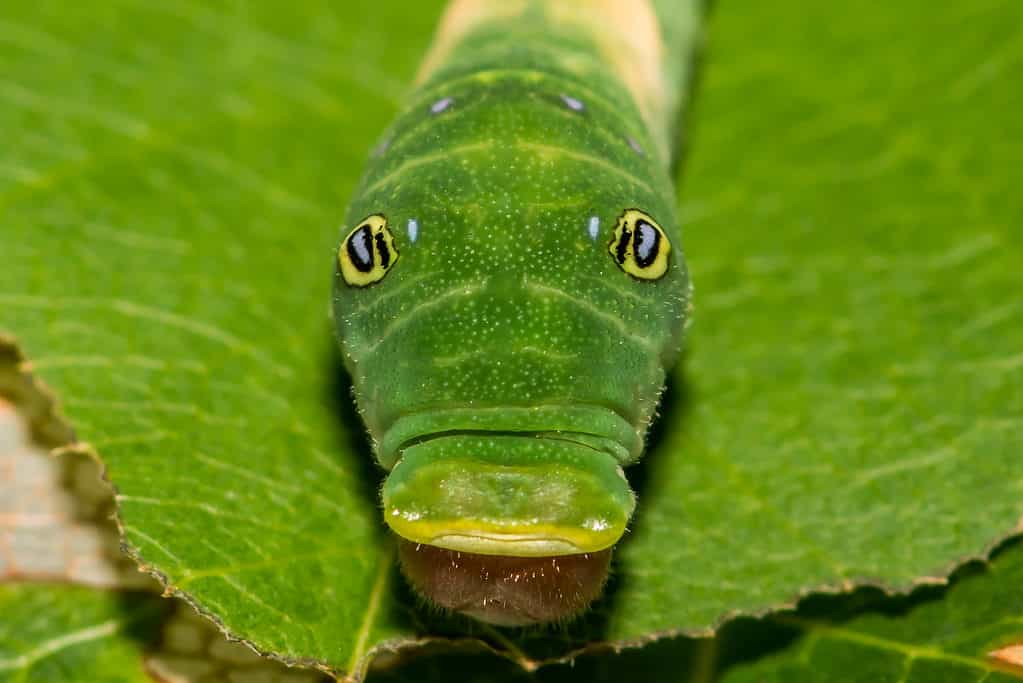
Another caterpillar found in Maine is the eastern
tiger
swallowtail.
©Jay Ondreicka/Shutterstock.com
Eastern tiger swallowtail caterpillars are fascinating creatures found in Maine. When young, these caterpillars sport brown and white colors that give them a striking resemblance to bird droppings. As they age, they transform into green color and exhibit two impressive false eyespots — a mix of black, yellow, and blue — on their thorax, located above and behind their actual eyes.
The caterpillars of the eastern tiger swallowtail butterfly feed on the leaves of various woody plants, including birch, tulip, cottonwood, wild cherry, ash, and willow.
Both the caterpillars and the adult butterflies of this species are harmless and devoid of any poisonous attributes.
8. Pipevine Swallowtail Caterpillar (Battus philenor)

Unsurprisingly, pipevine swallowtail caterpillars are actually toxic, even as butterflies.
©Sundry Photography/Shutterstock.com
Pipevine swallowtail caterpillars bear an uncanny resemblance to creatures straight out of a fantasy tale, flaunting a black hue punctuated with orange spots and possessing an elongated filament-like body. These caterpillars are unpalatable and toxic to birds and other creatures, a trait that persists even when they metamorphose into butterflies.
Also known as blue swallowtails, these caterpillars feed exclusively on the leaves of birthworts and Dutchman’s pipe.
9. Monarch Caterpillar (Danaus plexippus)
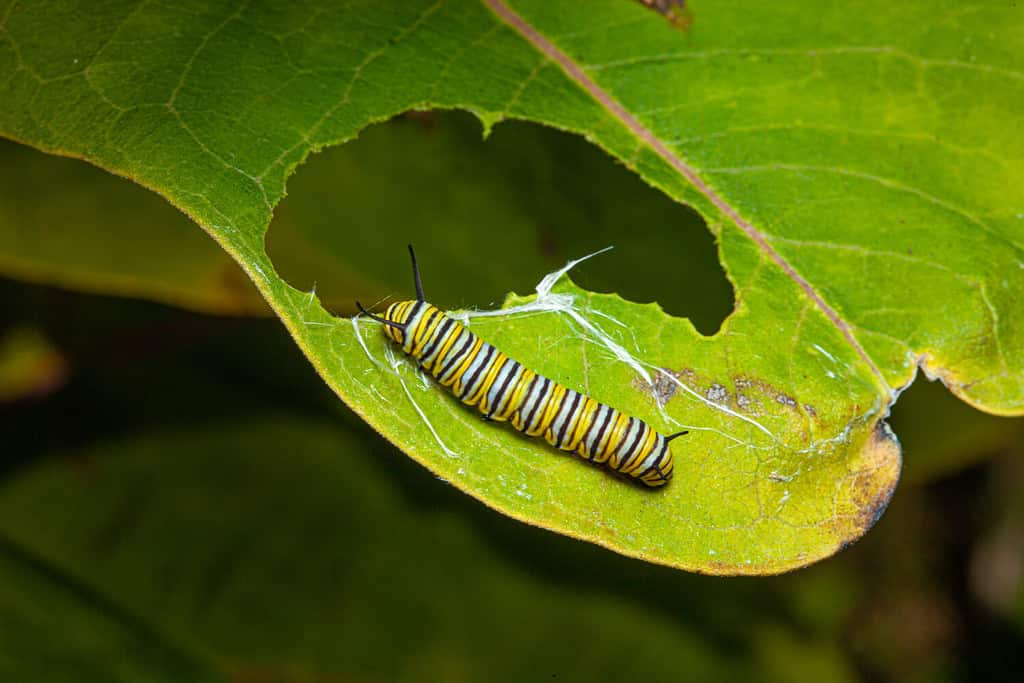
One of the most famous caterpillars in Maine is the monarch.
©K Hanley CHDPhoto/Shutterstock.com
In their caterpillar stage, monarchs are adorned with bands of yellow, black, and white. They exhibit antenna-like structures at both ends of their bodies and grow up to approximately two inches before transforming into butterflies.
Milkweed serves as the primary food source for the monarch butterfly. The absence of this plant would impede the caterpillar’s development. Importantly, the milkweed also makes the monarch caterpillar poisonous. These insects possess a potent toxin called cardenolides. This toxin plays a crucial role in safeguarding the species.
10. Gold Moth Caterpillar (Basilodes pepita)
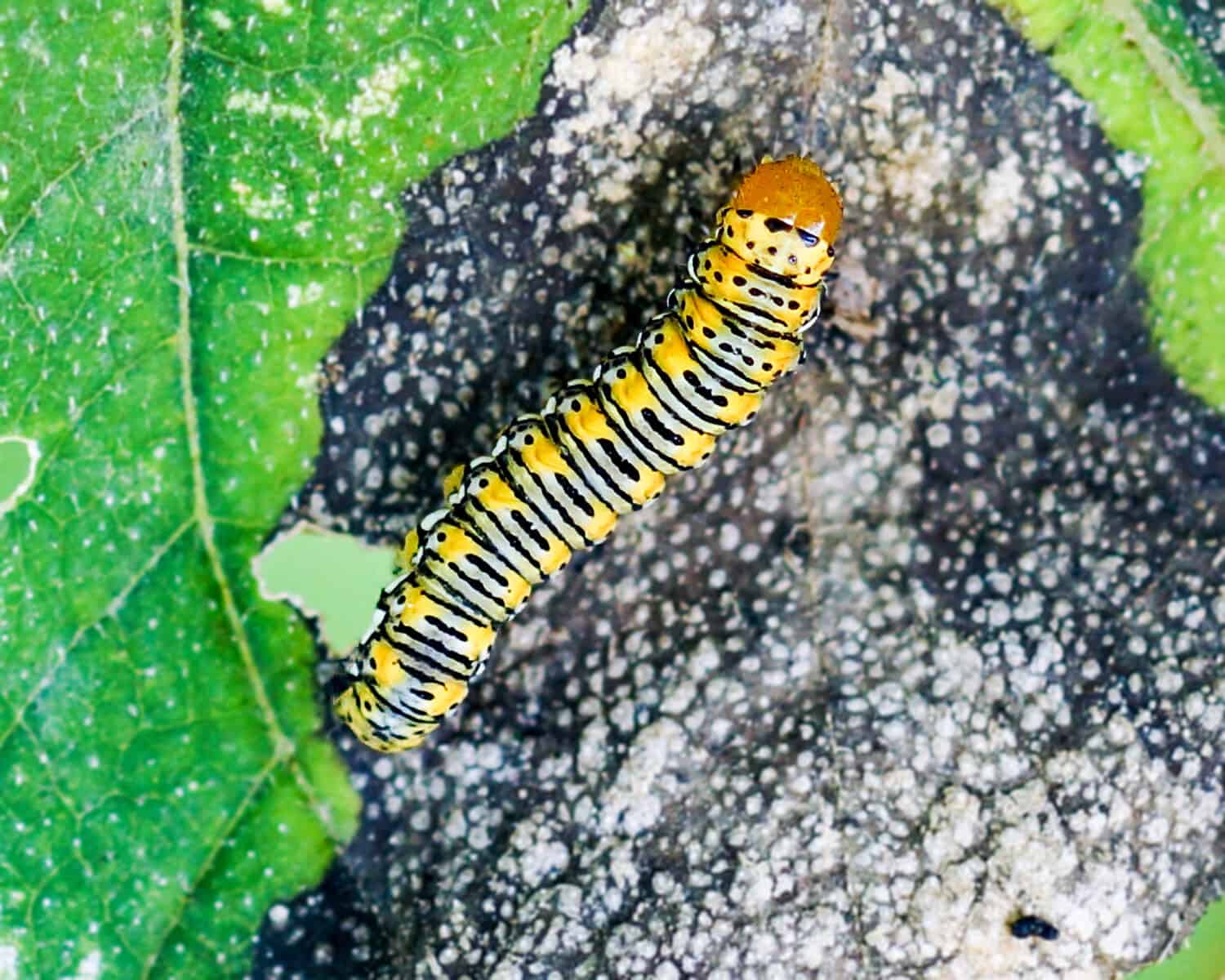
In Maine, the gold moth caterpillar typically eats wingstem or crownbeard.
©Wilfreda Wiseman/Shutterstock.com
The gold moth caterpillar measures around 1.57 inches in length. It typically flaunts an orange color with black bands encircling its body. Additionally, there is a line of white spots running along each side of the caterpillar. The gold moth caterpillar has a light orange head and a pale yellow belly.
Wingstem or crownbeard serves as the main food source for this caterpillar.
While the gold moth caterpillar might inflict a sting, it doesn’t bite. Though the sting itself isn’t venomous, ingesting the moth can be toxic.
11. Genista Broom Moth Caterpillar (Uresiphita reversalis)
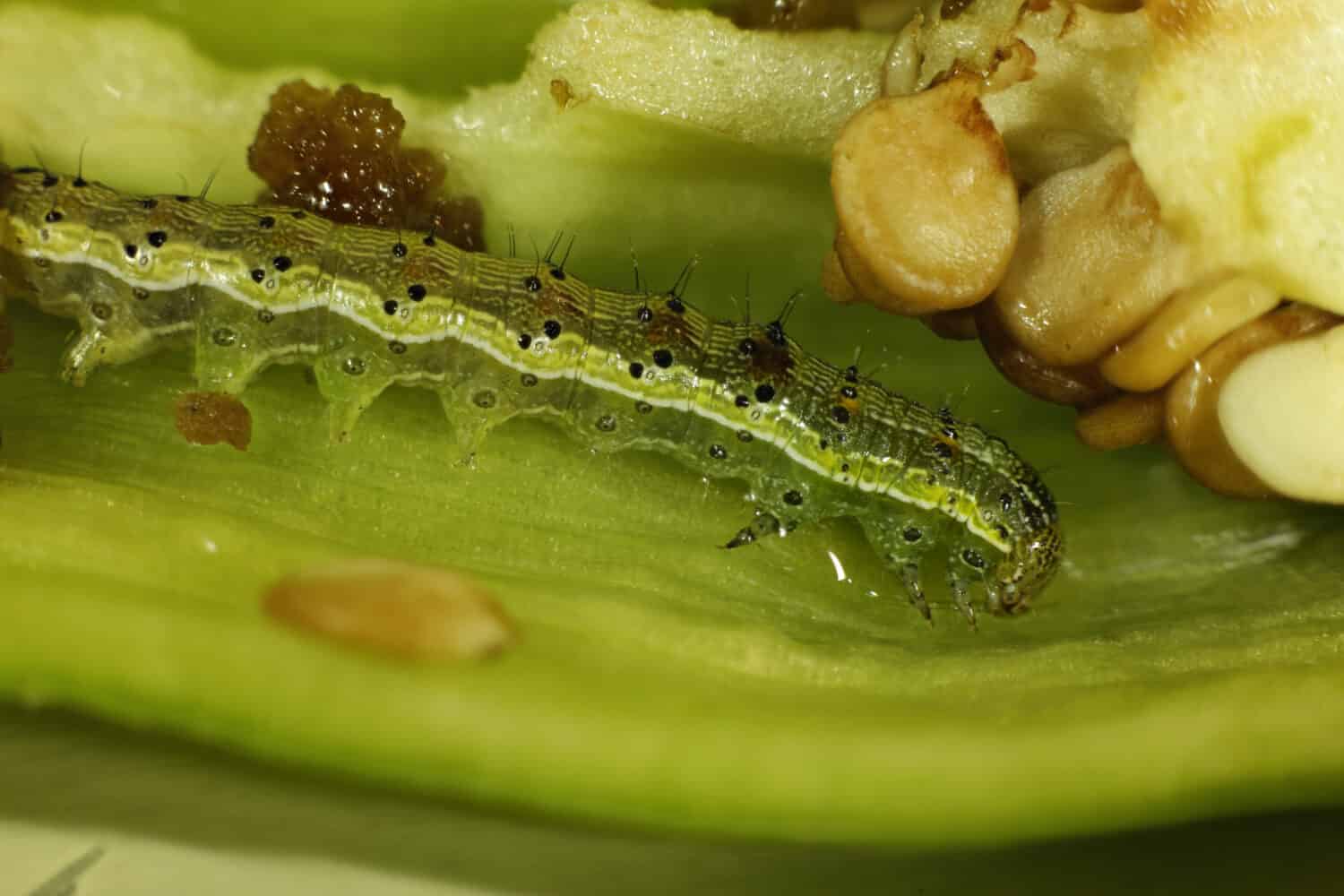
These caterpillars change colors as they grow, but they start off small and green.
©Melih Evren/Shutterstock.com
Genista broom moth caterpillars start off small and green, effortlessly camouflaging within the foliage. As they grow larger, they take on a brownish-green color, boasting raised black spots and vibrant yellow patches on each of their segments. Each black spot is tipped with a white dot that carries sparse, long white hairs. Its head mirrors this pattern, with a black color speckled with white dots.
The diet of these caterpillars primarily consists of acacia, brooms (Genista spp.), and Scotch brooms.
One unique trait of genista broom moth caterpillars is their ability to consume and store alkaloids from their host plants. This renders them distasteful or potentially toxic to mammals, birds, and certain insect predators. As such, they’re best observed and not consumed!
12. Viceroy Caterpillar (Limenitis archippus)
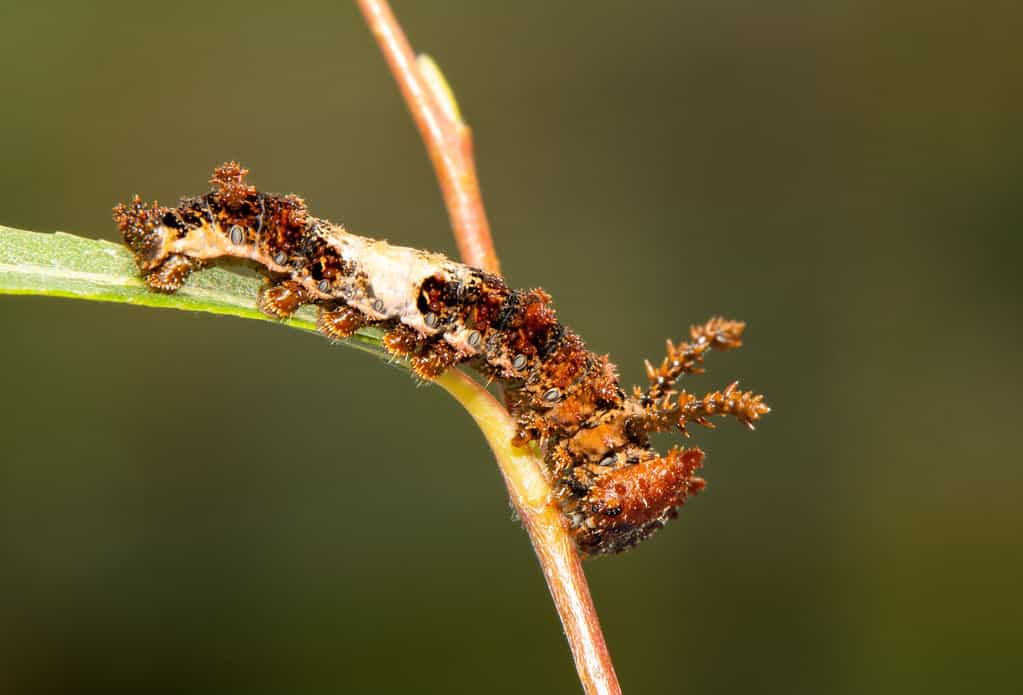
One of the least aesthetically pleasing caterpillars in Maine is the viceroy caterpillar.
©Sari ONeal/Shutterstock.com
Viceroy caterpillars bear a striking resemblance to bird droppings throughout their developmental stages. They may appear in shades of mottled brown or green and feature creamy blotches. They sport two distinctive horn-like projections on their thorax.
These caterpillars prefer willow leaves as their primary food source, although they also feed on poplar and aspen.
Be cautious around this caterpillar, as it can be harmful!
13. Painted Lady Caterpillar (Vanessa cardui)
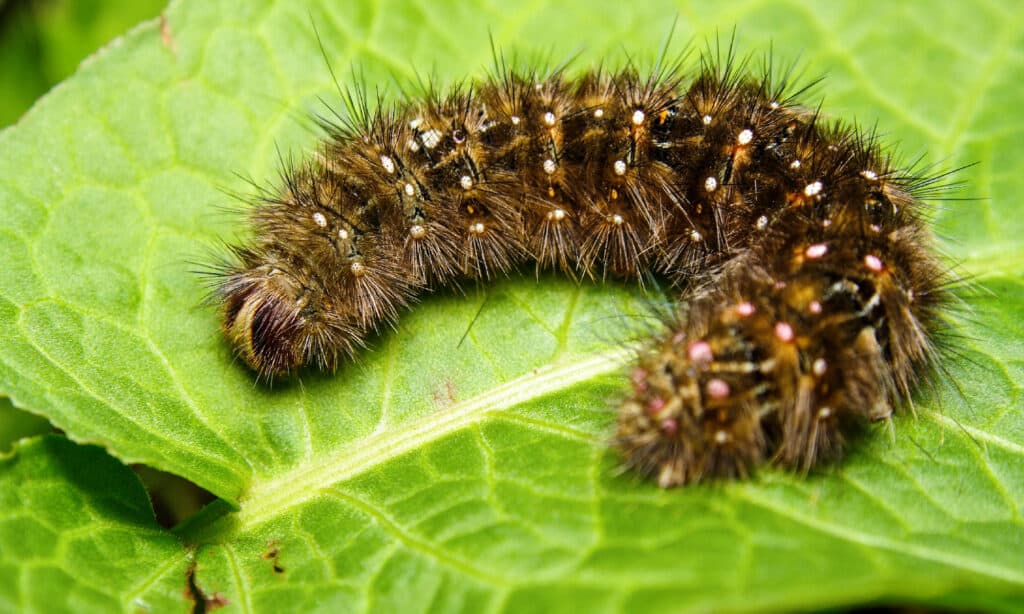
These caterpillars are black in color and feature white specks, yellow stripes, and plenty of spines!
©iStock.com/Andrew Waugh
Painted lady caterpillars have a black coloration dotted with minuscule white specks and feature a yellow stripe on either side of their body. Their bodies are coated in spines for added protection.
The caterpillars have a diet consisting of thistles, stinging nettles, and mallows.
Though painted ladies pose no harm to humans and their caterpillars can be safely handled, they have a unique defense mechanism. They accumulate toxins from their host plants, which they use to make themselves unappealing to potential predators.
14. Mourning Cloak Caterpillar (Nymphalis antiopa)

Mourning cloak caterpillars are black in color with white hairs and red-orange dots.
©Massimiliano Paolino/Shutterstock.com
Just like their adult counterparts, the caterpillars of mourning cloak butterflies have a predominantly dark hue, giving them an almost entirely black appearance at first glance. However, a closer inspection reveals subtle color variations. The caterpillar’s head is dark and embellished with extremely fine white hairs and specks. They also have a line of reddish-orange dots on their back.
Mourning cloak caterpillars mostly consume leaves from deciduous trees like willow, elm, and hackberry.
These caterpillars have venomous spines that may sting.
15. Browntail Moth Caterpillar (Euproctis chrysorrhoea)
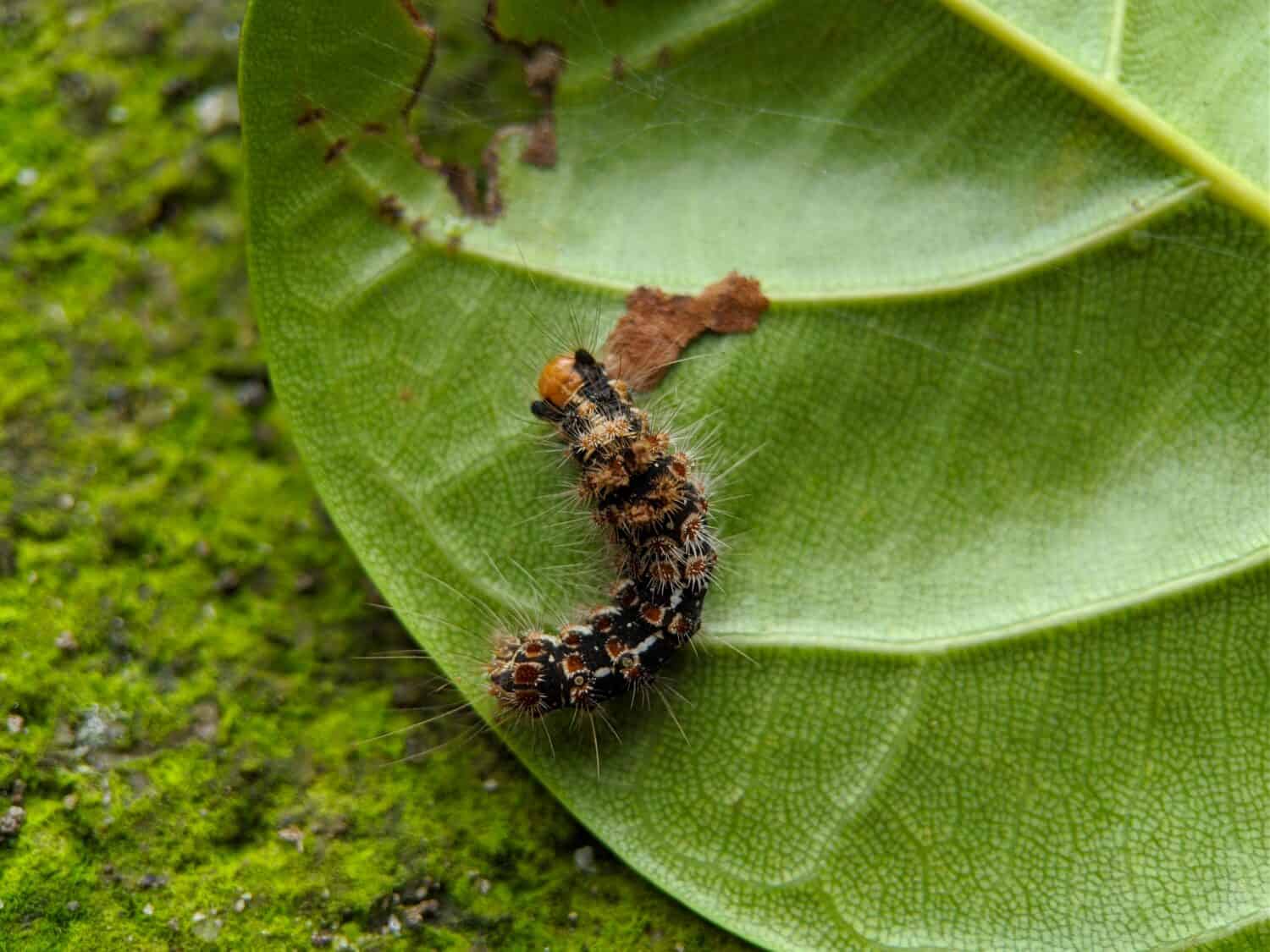
An invasive species in Maine, the browntail moth caterpillar has a very hairy body and eats a variety of trees and shrubs.
©Zikrieys Ahmad/Shutterstock.com
The browntail moth, an invasive species, has found a unique habitat along the Maine coast and Cape Cod. This moth not only impacts the forest ecosystem but also poses a threat to human health.
The caterpillars of this species are noticeable due to their hairy body. They feast on a diverse array of broadleaf trees and shrubs, with a particular fondness for oak, apple, crabapple, cherry, and pear.
It’s important to note that these caterpillars carry small toxic hairs that can induce a skin reaction akin to poison ivy in sensitive individuals. This reaction can occur from direct contact with the caterpillar or indirectly through exposure to hairs carried by the wind.
16. Imperial Moth Caterpillar (Eacles imperialis)

Ranging in color from green to black, the imperial moth caterpillar loves to eat pines, oaks, and maples.
©Matt Jeppson/Shutterstock.com
The imperial moth starts its life cycle as tiny, bright orange caterpillars with striking black spines. Over time, these caterpillars transform into substantial, chubby worms varying in color from green to brown and even almost black, with some brown versions showcasing distinctive orange spots. Interestingly, imperial moth caterpillars can reach incredible sizes, with some individuals reaching up to an impressive 5 inches in length!
These caterpillars enjoy a feast on a wide variety of trees, showcasing a particular affinity for pines, oaks, and maples.
Despite their common presence in gardens and the nuisance they often represent for gardeners, not many people know that they are poisonous! When in contact with human skin, it can cause irritation or burning. In severe cases, its toxin can cause blindness and even death when consumed.
17. Milkweed Tussock Moth Caterpillar (Euchaetes egle)
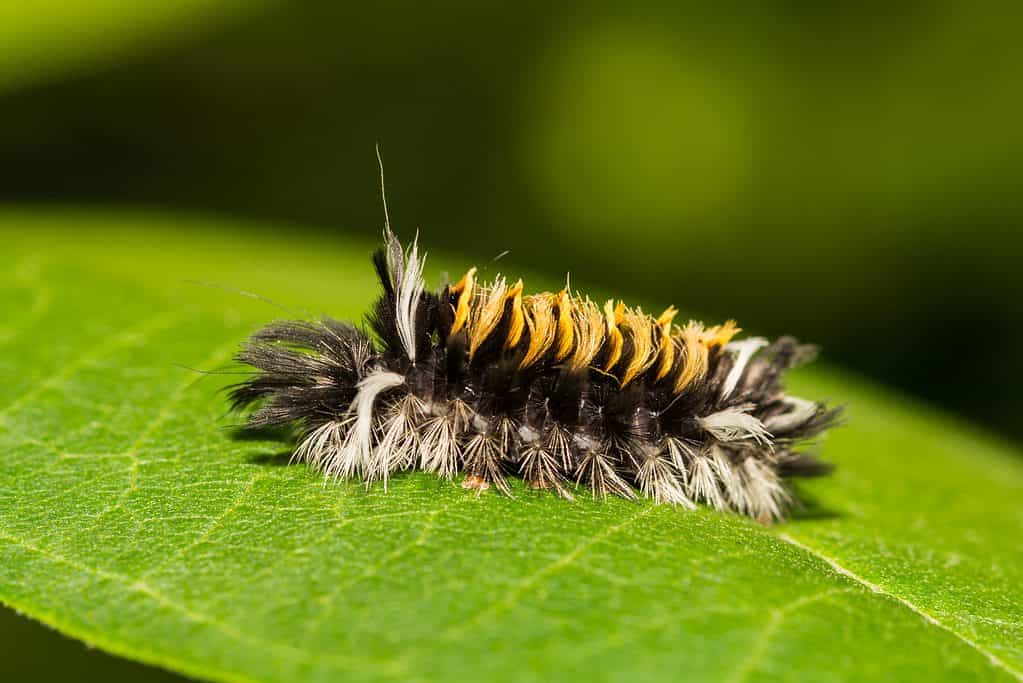
Milkweed tussock moth caterpillars produce toxic reactions to protect themselves against predators.
©Jay Ondreicka/Shutterstock.com
As they grow, milkweed tussock moth caterpillars develop a dense covering of hairs, exhibiting striking tufts in shades of black, orange, and white. This vibrant coloration has earned them the moniker of milkweed tiger moths. Over time, what starts as a large group of these caterpillars disperses into smaller pairs or even solo caterpillars.
Their dietary choices primarily include milkweeds and dogbanes.
While the milkweed tussock moth can produce toxic reactions, the severity varies widely. Their toxins primarily aim to deter predators and capture prey. Generally, they do not pose a fatal threat to humans.
18. Red Admiral Caterpillar (Vanessa atalanta)
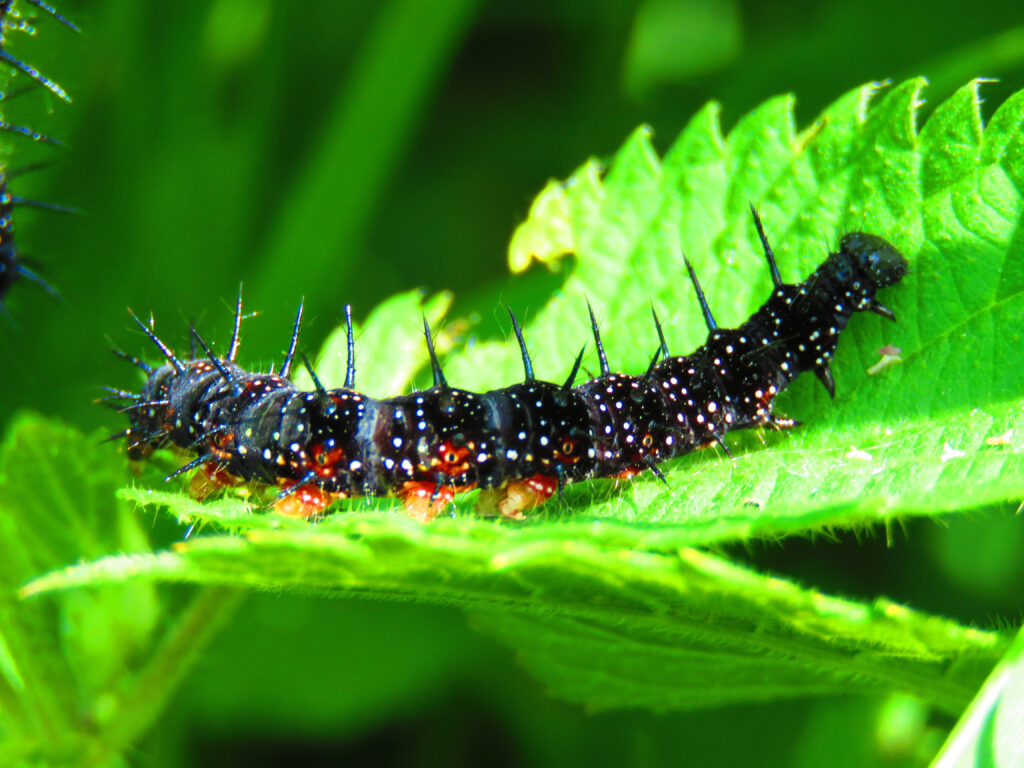
Red admiral caterpillars have many small bumps and dark spines.
©Przemyslaw Muszynski/Shutterstock.com
The appearance of red admiral caterpillars alters after each stage of their larval development, displaying a variety of colors such as black, greenish hues, white, or brown. They exhibit numerous small bumps and dark thorns.
Unlike most caterpillars that are commonly seen crawling and eating, red admiral caterpillars prefer to remain concealed. Their diet consists primarily of stinging nettles.
Despite their threatening appearance suggesting potential toxicity or painful stings, handling these caterpillars is completely safe.
Regions in Maine with the Most Caterpillars
The vibrant caterpillar population of Maine spreads across its diverse geographical settings. Particularly notable is Maine’s North Woods, a sprawling expanse of 10.5 million acres. The North Woods encompass ecosystems as varied as those across all of Europe, contributing to a climate gradient that provides diverse habitats for numerous caterpillar species.
This, along with the distinct environments of coastal, western, and central Maine, makes the state a dynamic haven for these intriguing creatures. Keep in mind that no matter where you are in the state, it’s always wise to avoid handling caterpillars you’re unfamiliar with for your safety.
Summary of 18 Caterpillars Found in Maine
| Number | Caterpillar | Type of Caterpillar | Poisonous/Venomous? |
|---|---|---|---|
| 1 | Bent-Line Dart Caterpillar | Moth | No |
| 2 | Black-Waved Flannel Caterpillar | Moth | Yes |
| 3 | Buck Moth Caterpillar | Moth | Yes |
| 4 | Cabbage Looper Caterpillar | Moth | No |
| 5 | Cecropia Moth Caterpillar | Moth | No |
| 6 | Eastern Black Swallowtail Caterpillar | Butterfly | No |
| 7 | Eastern Tiger Swallowtail Caterpillar | Butterfly | No |
| 8 | Pipevine Swallowtail Caterpillar | Butterfly | Yes |
| 9 | Monarch Caterpillar | Butterfly | Yes |
| 10 | Gold Moth Caterpillar | Moth | No |
| 11 | Genistra Broom Moth Caterpillar | Moth | Yes |
| 12 | Viceroy Caterpillar | Butterfly | Yes |
| 13 | Painted Lady Caterpillar | Butterfly | No |
| 14 | Mourning Cloak Caterpillar | Butterfly | Yes |
| 15 | Browntail Moth Caterpillar | Moth | Yes |
| 16 | Imperial Moth Caterpillar | Moth | Yes |
| 17 | Milkweed Tussock Moth Caterpillar | Moth | Yes |
| 18 | Red Admiral Caterpillar | Butterfly | No |
The photo featured at the top of this post is © Wilfreda Wiseman/Shutterstock.com
Thank you for reading! Have some feedback for us? Contact the AZ Animals editorial team.






